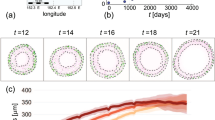Abstract
Nonlinear regression models are commonly used in toxicology and pharmacology. When fitting nonlinear models for such data, one needs to pay attention to error variance structure in the model and the presence of possible outliers or influential observations. In this paper, an M-estimation based procedure is considered in heteroscedastic nonlinear regression models where the standard deviation is modeled by a nonlinear function. The methodology is illustrated using toxicological data.




Similar content being viewed by others
References
Avalos, M., Mak, C., Randall, P. K., Trzeciakowski, J.P., Abell, C., Kwan, S.-W., and Wilcox, R. E. 2001. Nonlinear analysis of partial dopamine agonist effects on cAMP in C6 glioma cells. Journal of Pharmacological and Toxicological Methods 45:17–37.
Barata, C., Baird, D.J., Nogueira, A.J.A., Soares, A.M.V.M., and Riva, M.C. 2006. Toxicity of binary mixtures of metals and pyrethroid insecticides to Daphnia magna Straus. Implications for multi-substance risks assessment. Aquatic Toxicology 78:1–14.
Carroll, R.J., and Ruppert, D. 1988. Transformation and weighting in regression. New York: Chapman and Hall.
Crofton, K.M., Paul, K.B., DeVito, M.J., and Hedge, J.M. 2007. Short-term in vivo exposure to the water contaminant triclosan: Evidence for disruption of thyroxine. Environmental Toxicology and Pharmacology 24:194–197.
Davidian, M., and Carroll, R.J. 1987. Variance function estimation. Journal of the American Statistical Association 82:1079–1091.
Gaylor, D.W., and Aylward, L.L. 2004. An evaluation of benchmark dose methodology for non-cancer continuous-data health effects in animals due to exposures to dioxin (TCDD). Regulatory Toxicology and Pharmacology 40:9–17.
Hill, A.V. 1910. The possible effects of the aggregation of the molecules of haemoglobin on its dissociation curves. Journal of Physiology 40(Suppl):iv–vii.
Jureĉková, J., and Sen, P.K. 1996. Robust statistical procedures, asymptotics and interrelations. New York: Wiley.
Kutner, M.H., Nachtsheim, C.J., Neter, J., and Li, W. 2005. Applied linear statistical models, 5th edn. New York: McGraw-Hill/Irwin.
Maronna, R.A., Martin, D.R., and Yohai, V.J. 2006. Robust statistics: Theory and methods. New York: Wiley.
Morris, J.B., Symanowicz, P., and Sarangapani, R. 2002. Regional distribution and kinetics of vinyl acetate hydrolysis in the oral cavity of the rat and mouse. Toxicology Letters 126:31–39.
National Toxicology Program 2007. NTP toxicity studies of sodium dichromate dihydrate (CAS no. 7789-12-0) administered in drinking water to male and female F344/N rats and B6C3F1 mice and male BALB/c and am3-C57BL/6 mice. Toxicity Report Series vol. 72, 1–G4. U.S. Department of Health and Human Services, Public Health Service, National Institutes of Health, RTP, NC.
Nitcheva, D.K., Piegorsch, W.W., West, R.W., and Kodell, R.L. 2005. Multiplicity-adjusted inferences in risk assessment with non-quantal data. Journal of Biopharmaceutical Statistics 15:17–31.
Peddada, S.D., Lobenhofer, L., Li, L., Afshari, C., Weinberg, C., and Umbach, D. 2003. Gene selection and clustering for time-course and dose-response microarray experiments using order-restricted inference. Bioinformatics 19:834–841.
Peddada, S.D., Harris, S., Zajd, J., and Harvey, E. 2005. ORIOGEN: order restricted inference for ordered gene expression data. Bioinformatics 21:3933–3934.
Piegorsch, W.W., and West, R.W. 2005. Benchmark analysis: Shopping with proper confidence. Risk Analysis 25:913–920.
Pounds, J.G., Haider, J., Chen, D.G., and Mumtaz, M. 2004. Interactive toxicity of simple chemical mixtures of cadmium, mercury, methylmercury and trimethyltin: Model-dependent responses. Environmental Toxicology and Pharmacology 18:101–113.
Sand, S., von Rosen, D., Eriksson, P., Fredriksson, A., Viberg, H., Victorin, K., and Filipsson, A.F. 2004. Dose-response modeling and benchmark calculations from spontaneous behavior data on mice neonatally exposed to 2,2′,4,4′,5-pentabromodiphenyl ether. Toxicological Sciences 81:491–501.
Sanhueza, A.I., Sen, P.K., and Leiva, V. 2009. A robust procedure in nonlinear for repeated measurements. Communications in Statistics—Theory and Methods 38:138–155.
Seber, G.A.F., and Wild, C.H. 1989. Nonlinear regression. New York: Wiley.
Velarde, G., Ait-aissa, S., Gillet, C., Rogerieux, F., Lambre, C., Vindimian, E., and Porcher, J.M. 1999. Use of transepithelial electrical resistance in the study of pentachlorophenol toxicity. Toxicology in Vitro 13:723–727.
Wu, Y., Piegorsch, W.W., West, W., Tang, D., Petkewich, M.O., and Pan, W. 2006. Multiplicity-adjusted inferences in risk assessment: Benchmark analysis with continuous response data. Environmental and Ecological Statistics 13:125–141.
Acknowledgements
This research was supported, in part, by the Intramural Research Program of the NIH, National Institute of Environmental Health Sciences [Z01 ES101744-04]. We thank Drs. Anastasia Ivanova and Gregg Dinse as well as the editor and the referee for many important comments which helped improve the presentation of the manuscript.
Author information
Authors and Affiliations
Corresponding author
Appendix: Notations in Theorem 1
Appendix: Notations in Theorem 1
We state the definitions of the matrices and related quantities using in Theorem 1 as follows:
-
(i)
$$ \boldsymbol{\Gamma}_{3}({\boldsymbol \theta}, {\boldsymbol \tau})=\left( \begin{array}{cc} \boldsymbol{\Gamma}_{31}({\boldsymbol \theta},{\boldsymbol \tau}) & \mathbf{0} \\ \mathbf{0} & \boldsymbol{\Gamma}_{32}({\boldsymbol \theta},{\boldsymbol \tau}) \end{array}\right), $$
where \({\boldsymbol \Gamma}_{31}({\boldsymbol \theta},{\boldsymbol \tau})=\lim_{n\rightarrow\infty}\frac{1}{n}{\boldsymbol \Gamma}_{31n}({\boldsymbol \theta},{\boldsymbol \tau}),\) \({\boldsymbol \Gamma}_{32}({\boldsymbol \theta},{\boldsymbol \tau})=\lim_{n\rightarrow\infty}\frac{1}{n}{\boldsymbol \Gamma}_{32n}({\boldsymbol \theta},{\boldsymbol \tau}),\)
$$ {\boldsymbol \Gamma}_{31n}({\boldsymbol \theta},{\boldsymbol \tau}) =\sigma_{\psi1}^2\sum_{i=1}^n u(\mathbf{x}_i)k^2(\mathbf{z}_i,{\boldsymbol \tau}) \mathbf{f}_{{\boldsymbol \scriptstyle \theta}} (\mathbf{x}_i,{\boldsymbol \theta}) \mathbf{f}^t_{{\boldsymbol \scriptstyle \theta}} (\mathbf{x}_i,{\boldsymbol \theta}), $$$$ {\boldsymbol \Gamma}_{32n}({\boldsymbol \theta},{\boldsymbol \tau}) =\sigma_{\psi2}^2\sum_{i=1}^n v(\mathbf{x}_i)k^2(\mathbf{z}_i,{\boldsymbol \tau}) {\boldsymbol \sigma}_{{\boldsymbol \scriptstyle \tau}} (\mathbf{z}_i,{\boldsymbol \tau}) {\boldsymbol \sigma}^t_{{\boldsymbol \scriptstyle \tau}} (\mathbf{z}_i,{\boldsymbol \tau}), $$\(\sigma_{\psi1}^2u(\mathbf{x})=E\psi^2(\epsilon)(<\infty),\) \(\sigma_{\psi2}^2v(\mathbf{x})=\mbox{Var}\{\psi(\epsilon)\epsilon\}(<\infty),\) and \(\epsilon=\frac{y-f(\mathbf{x},{\boldsymbol \scriptstyle\theta})} {\sigma(\mathbf{z},{\boldsymbol \scriptstyle\tau })}.\)
-
(ii)
$$ \boldsymbol{\Gamma}_{5}({\boldsymbol \theta},{\boldsymbol \tau})=\left( \begin{array}{cc} \boldsymbol{\Gamma}_{1}({\boldsymbol \theta},{\boldsymbol \tau}) & \mathbf{0} \\ \mathbf{0} & \boldsymbol{\Gamma}_{2}({\boldsymbol \theta},{\boldsymbol \tau}) \end{array}\right), $$
where \({\boldsymbol \Gamma}_1({\boldsymbol \theta},{\boldsymbol \tau})=\lim_{n\rightarrow\infty}\frac{1}{n}{\boldsymbol \Gamma}_{1n}({\boldsymbol \theta},{\boldsymbol \tau}),\) \({\boldsymbol \Gamma}_2({\boldsymbol \theta},{\boldsymbol \tau})=\lim_{n\rightarrow\infty}\frac{1}{n}{\boldsymbol \Gamma}_{2n}({\boldsymbol \theta},{\boldsymbol \tau}),\)
$$ {\boldsymbol \Gamma}_{1n}({\boldsymbol \theta},{\boldsymbol \tau}) =\gamma_{2}\sum_{i=1}^n k^2(\mathbf{z}_i,{\boldsymbol \tau}) \mathbf{f}_{{\boldsymbol \scriptstyle\theta}} (\mathbf{x}_i,{\boldsymbol \theta}) \mathbf{f}^t_{{\boldsymbol \scriptstyle\theta}} (\mathbf{x}_i,{\boldsymbol \theta}), $$$$ {\boldsymbol \Gamma}_{2n}({\boldsymbol \theta},{\boldsymbol \tau}) =\sum_{i=1}^n \left\{\frac{2\gamma_{1}+\gamma_3-1} {\sigma^2(\mathbf{z}_i,{\boldsymbol \tau})} {\boldsymbol \sigma}_{{\boldsymbol \scriptstyle \tau}} (\mathbf{z}_i,{\boldsymbol \tau}) {\boldsymbol \sigma}^t_{{\boldsymbol \scriptstyle \tau}} (\mathbf{z}_i,{\boldsymbol \tau}) +\frac{1-\gamma_1}{\sigma(\mathbf{z}_i,{\boldsymbol \tau})} \boldsymbol{\Sigma}_{{\boldsymbol \scriptstyle \tau}} (\mathbf{z}_i,{\boldsymbol \tau})\right\}, $$\(\boldsymbol{\Sigma}_{{\boldsymbol \scriptstyle\tau}} (\mathbf{z}_i,{\boldsymbol \tau}) =(\partial^2/\partial{\boldsymbol \tau} \partial{\boldsymbol \tau}^t)\sigma(\mathbf{z}_i,{\boldsymbol \tau}),\) γ 1 = E{ψ(ϵ)ϵ}( ≠ 0), γ 2 = Eψ′(ϵ)( ≠ 0), and \(\gamma_3=E\{\psi'(\epsilon)\epsilon^2\}(\neq 0).\)
-
(iii)
$$ {\boldsymbol \nu}_n({\boldsymbol \theta},{\boldsymbol \tau})=\left(\frac{1}{n}\boldsymbol{\Gamma}_{2n}({\boldsymbol \theta}, {\boldsymbol \tau})\right)^{-1}\frac{\gamma_1-1}{n}\sum_{i=1}^nk(\mathbf{z}_i,{\boldsymbol \tau}) {\boldsymbol \sigma}_{{\boldsymbol \scriptstyle \tau}}(\mathbf{z}_i,{\boldsymbol \tau}). $$
Rights and permissions
About this article
Cite this article
Lim, C., Sen, P.K. & Peddada, S.D. Statistical inference in nonlinear regression under heteroscedasticity. Sankhya B 72, 202–218 (2010). https://doi.org/10.1007/s13571-011-0013-0
Received:
Revised:
Accepted:
Published:
Issue Date:
DOI: https://doi.org/10.1007/s13571-011-0013-0




